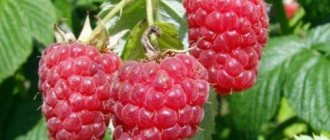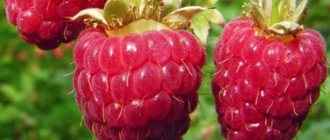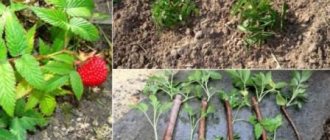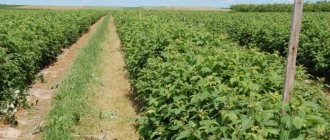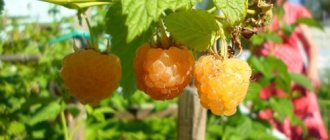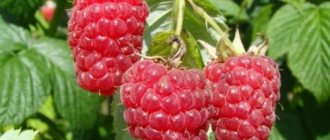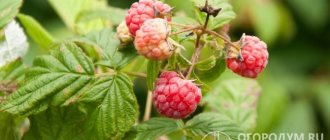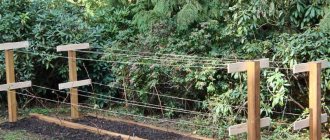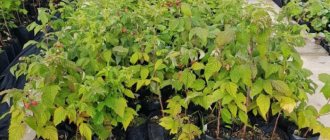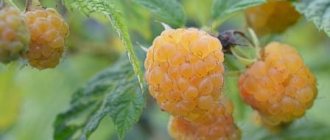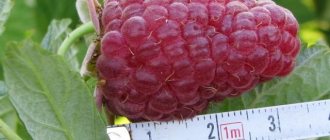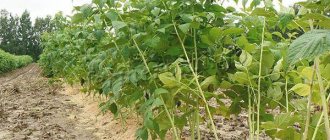Remontance is a French term. This means that Old Gold raspberries bloom and bear fruit in one growing season. Thanks to the crossing of two varieties Taylor and Rubus, this crop appeared in the USA, in New Hampshire, in 1967.
AGRO PREMIUM is an innovative, environmentally friendly plant activator, without chemicals, that protects berries, fruits and vegetables from pests and diseases, increases seed germination, stimulates root formation and plant growth, and significantly increases productivity.
The fruits of the remontant variety are yellow in color, with medium ripening. A crop with large, beautiful, conical berries. For the second year after planting, it produces a harvest.
Even in the rain, bees pollinate bushes. Plants with universal purposes. In the first half of July they produce one harvest. At the end of August you can collect the 2nd.
Description of repair Old Gold
Shrubs with large, yellow fruits, juicy and sweet, weighing up to 5-7 g. With a unique aroma of forest raspberries. 2-4 kg are collected from each bush. With good agricultural technology, up to 9 kg of berries are harvested.
Raspberries are early, self-fertile. With powerful, tall, straight-growing bushes. 1.5-2 m high. They not only delight with amber berries, but also become a decoration of the garden.
Important! Plants are cultivated either upright or on trellises. It is frost-resistant.
Farmers grow it for sale. Only in this case, the berry is removed almost unripe. It then lasts longer and tolerates transportation well.
A crop with high immunity to diseases such as powdery mildew and fungal infections.
Photo of a bush
In numerous photos of Alt Gold raspberries presented on the Internet, you can see that this is a fairly tall shrub with a thick trunk and strong branches that do not bend even under the heavy weight of ripe berries.
We recommend that you read the reasons why gooseberries do not bear fruit
Raspberry plant breakdown
Old Gold raspberries prefer sun, but can be partially shaded, especially if grown in the south. Violent winds should not interfere with its development.
Important! It is necessary to plant where there will be the most snow in winter. Because in winter the stems bend down and they overwinter under the snow.
The soil must be enriched with organic matter. If the areas have poor, rocky, sandy or chalky soil, then it is necessary to add a mixture of humus every year.
Groundwater should not reach the surface of the earth by 1.5 m. The bases of bushes should not be flooded during the spring thaw. Because the roots will be deprived of oxygen and die.
It is necessary for gardeners, according to the recommendations of experienced farmers, to find the “golden mean” between drainage and a moistened substrate.
If the substrate cannot retain moisture and there is poor drainage, then the plants will need to be watered abundantly. Keep the soil acid between 6.5 and 7 pH. If more, reduce with lime. But you can’t overdo it, otherwise the bush will develop calcareous chlorosis.
More: Large-fruited raspberry Biryusinka
More on the topic: Polish large-fruited raspberries Sokolica
Standard varieties
In the last decades of the last century, standard varieties of Russian selection were created. This is Tarusa, Krepysh, Monika, Skazka. The Tarusa and Krepysh varieties are similar in appearance. The leaves and roots differ slightly in appearance. Experts believe that there is no point in growing both varieties. Reviews recommend growing the Krepysh raspberry tree for gardeners involved in the propagation and sale of bushes, and for those who grow berries - Tarusa.
The stem of Tarusa differs from many others in the absence of thorns. Brown color. The height of the shoots is about 2 m. The leaves are large, with noticeable veins. Young stems are covered with a waxy coating. The fruits are oblong, oval, red, the weight of one can reach 12 g. They taste sweet, tender, with a pleasant taste and aroma.
Planting sweet raspberries Old Gold
Seedlings are planted in their dormant state. During the autumn season or immediately after winter.
- They clear the future raspberry field of weeds.
- Dig with organic fertilizers (rotted manure), phosphorus (superphosphates), potassium (potassium chloride).
- All shoots are planted at a distance of up to 45 cm.
- The roots are adjusted so that they look down.
- They are buried 5-8 cm, sprinkled with soil and lightly compacted.
After planting Old Gold raspberries, the stems are cut to 25-40 cm and watered. The earth is mulched: manure, compost.
With the onset of spring, raspberries are fed with mineral fertilizers:
- carbamide with 18-20 g (urea);
- superphosphates from 45-50 g;
- potassium sulfate with 25-28 g or ash - 120 g.
Again, the plants are given mulch with organic matter.
More: Medium-early unpretentious raspberries Stoleshnik
Raspberry tree
Not so long ago, remontant raspberry varieties became popular. They bear fruit all summer and autumn. But the fruits do not ripen on one stem. In the spring they form on last year's shoots, and towards the end of summer - on young ones that appeared in the spring.
If last year's shoots are cut off in autumn or early spring, then the entire harvest will be formed on young ones. The fruits will begin to ripen a little earlier and will be larger.
One of the disadvantages of this type of variety is the density of raspberry plantings. By mid-summer, the young vines grow, last year's ones intertwine with them, and all fall to the ground together. Standard raspberry varieties are largely free of these disadvantages. The stems are strong and can hold a crop and a mass of leaves. Although tying them to a trellis will not hurt them. The root growth is destroyed soon after its appearance.
The raspberry tree is a representative of a new generation of this plant. This is the name given to intensive-type varieties with long, strong stems.
One of the progenitors of many intensive-type varieties is the Glen Ample variety (Scotland). This red raspberry tree produces 3.5 kg of fruit per bush. Reviews from gardeners claim that during industrial plantings, about 20 kg of fruits are harvested per hectare.
The subsequent varieties were Glen Fine with an extended fruiting period and Glen Lyon early. The fruits of the Magna variety are larger than those of Glen Ampl. Now many promising varieties of raspberry trees have been created, including remontant ones.
The color of the berries is distinguished by the raspberry tree Gold. Consumer reviews say that they are tasty and aromatic.
Pruning old branches at Old Gold
Raspberry root systems are long-lived, but the stems themselves live only 2 years. Yearlings develop with leaves and buds. Two-year-olds - with flowering, fruiting and dying.
Weeds and shoots that may appear, jumping 20-22 cm from the main rows, are removed. After rooting, the raspberry tree is pruned annually. This is a centuries-old principle.
With the onset of mid-summer, old growth is eliminated; these are the shoots that are shortened during planting.
Nutrition
Any raspberry loves to eat, yellow remontant is no exception. Under normal conditions, a tap root develops; adventitious roots do not spread widely.
Knowing this, when planting, we lay humus or vermicompost to a depth of 60 cm to stimulate the growth of the tap root and provide it with nutrition. A well-fed bush with a deep root system will withstand drought well.
There should be a layer of fertilizer near the surface. When planting, fertile soil is also laid near the surface, a mixture with humus or sifted manure that has lain for 3 years. Sift for larvae.
Subsequently, fertilizers are applied to the surface around the bush, taking into account the development of the roots. In autumn humus or manure. In the spring, water with an infusion of chicken manure at a ratio of 1:20 or 1:10; the fresher the solution, the lower the concentration.
You can also apply mineral fertilizers; the application rates and times are indicated on the packages.
Foliar feeding (by leaf) is done according to the following principle:
- In autumn, phosphorus and potassium for the development of the root system. At the same time, calcium is added.
- In the spring, every 2 weeks - nitrogen or complex with a predominance of nitrogen, because an annual shoot needs time to grow.
- In the summer, once every 2 weeks, potassium or complex with a predominance of potassium.
It is imperative to provide the bush with iron; this is what the berries are intensively removed from the soil. You need zinc, copper, and other microelements for fruiting, don’t forget about them. Good humus and vermicompost have all this.
If you were not satisfied with fruiting in the previous year, you can improve the situation in the new year by increasing nutrition.
In acidic soil, raspberries do not absorb nutrients well. You cannot quickly make acidic soil slightly alkaline. Take care of its deoxidation in the fall if you plant in the spring.
And, of course, for good absorption of nutrition you need sun, a sunny area.
Raspberry tree: reviews
Gardeners note many positive qualities of the raspberry tree:
- High productivity, with proper pruning it can produce two harvests per season. The berries are very large (up to 14-16 g), beautiful elongated shape with a bright red color and shiny. They are easy to remove.
- The berries have excellent taste and aroma, are dense and withstand transportation well. The berries of the Tarusa raspberry tree can be consumed not only fresh, but also for all types of processing, because they have few seeds and they are very small.
- The root system resembles the root of a tree and does not produce much growth, that is, it does not “spread” throughout the area. When raspberries are grown for berries, and not for planting material, this quality is a big plus.
- It is possible to grow without supports or stakes, since the plant has tough, thick and strong shoots that do not have thorns.
- High winter hardiness and relatively good resistance to many diseases.
Raspberry variety Skazka (Raspberry tree Skazka) is the newest standard raspberry variety, which is a variety of the tree-like Tarusa raspberry, popular among gardeners. In this article, you will get to know this amazing variety better, learn the features of planting raspberry trees of the Skazka variety, the basic principles of caring for plants, methods of propagating them, and you will also be able to read reviews from gardeners and admire photographs of fruit-bearing bushes.
Double pruning of standard raspberries
Double pruning - the first plucking of the top (5 or 10 cm) is carried out when the shoots grow by 50–60 cm. The procedure promotes the active germination of side shoots.
Next year, these branches need to be shortened by 15 cm, the bush will acquire many fruitful shoots. After harvesting, the fruit-bearing shoots are cut off. It is better not to wait until spring; cut them in August so that the replacement shoots ripen well.
In subsequent years, shaping consists of pruning dry branches (in May), no more than 7 shoots should remain on the bush. In June the top is cut off, and in July the side branches are shortened.
Landing
There are no special requirements for agricultural technology for planting standard raspberry varieties. Planting is carried out in the spring (April) or autumn (September-October), but, according to experts, spring planting is more preferable. If we have time to plant before the buds open, we will get excellent survival and fruiting of raspberries the very next year. The planting location has a significant influence on the further development and fruiting of the variety. For Skazka raspberry trees, choose sunny, windless areas with loose, nutritious soil.
You might be interested! The most popular variety of yellow raspberries is the Yellow Giant.
Planting methods:
- into the hole. For each plant, a separate hole measuring 0.5 x 0.5 m and a depth of 0.4 m is dug, the distance between plants is approximately 1 m, between rows 1.7-2.0 m.
- into the trench. A single trench is dug for a row of raspberries. The width of the trench is 0.5 m, the distance between plants in a row is 0.5-0.7 m, the distance between trenches is 2.0 m. The depth of the trench is 0.4 - 0.5 m.
Forum statistics
207036 Messages in 1634 Topics from 5593 Users. Last user: Amaya Last message: “Let's talk about the weather in Vash...” ( Today at 07:52:22 ) Latest messages on the forum.
Now on the forum
72 Guests, 12 Users
Users in the last 15 minutes: ElenkaF, kosmos, Yura, Evgeniy52, GALINA ANOKHINA, DorontsovPeter, ZaycevAS, Alex65, 77volt, 64nikolay64, Vova Kapran, Vasily 53 [Blocked] [Section Moderator] [Forum Moderator]
Maximum online today: 84 . All-time maximum online: 2758 (28 July 2021, 17:22:51)
Users who visited the forum in the last 24 hours
Total: 293
(Visible: 292, Hidden: 1) 1963, ElenkaF, kosmos, Evgeniy52, Yura, GALINA ANOKHINA, DorontsovPeter, ZaycevAS, Alex65, 77volt, 64nikolay64, Vova Kapran, Vasily 53, zsb, Polina77, spotlight, Mikhail Alekseevich, Svetla77 7, Quiet , Marshal, Nikolay S., therapist, Liza, Capricorn, lomakin1969, Alexander Vl., Elvira2017, Andrey76, Slavka, Mikhail77, Tatyana B, Cherkessk, Eugene, Leonidych, vladimirM, yotmast, mers, Serg1707, SNovichek, hanter64, znakomij, Alexander K, Vardan, Sergey Fer, Anatoly Sivkov, Alexey V, Ilya 77, Andrey Gladilin, Tatyana A., Belgorodets, in Astrakhan, Oksana Kopp, sem_en, Vladimir 153, skier, Igor Viktorovich, slavalimon, Primorets, OlgaOs, SANYCH, 31rus, mystic69, Andrey Tsvetkov, Buba, igor222, Elena Z, vlad51, Kenig, Nikolay Rex, Sergey 1965, Vladimir Buturlakin, DSW, psv1960, Dmitry 77, Vasily V., Vyacheslav03, Natalia Nikolaevna, Sergey Tashchiyan, Igor Sergeevich, alexsandr , kvg, Pioneer, Polyanina Ekaterina, nicson7, Elena Aleshchenko, Alexander-ask-34, Verona, Igor F., Taker, Henry, Yuri72, L.A.P., Gaivoronsky Yuri, Sergeevich, Sergey Chistokletov, Svetlana Streletskaya, Galinka Aleksey Deminov, Naumov Igor, Vyacheslav136, Gryvymi, Katrin, Andsanych, Alexander Mikhno, Grandfather, Filippov Oleg, Vladimir ++, Lydia58, Alexander Bryansky, Vladimir-Kanevskaya, Dil, Amber7394, Marina Protasova, Lynx, Alexander66, Alexander66, Alexander66. Natalia M, Mikhail Fesenko, Amaya, Alexander71, Boris 1952, tsv, Maximilian, 25nata35, nadia, Igor_K, Alexander Kolesnikov, Ivan Levin, Pitko, weather forecaster, eSAa, cecet71, atseton, Alexander Smirnov, Vladimir Kostochkin, Vladimir Berdnikov, Gocha, pioneer-2, LeXa_KoT, Sergey 61, Sergey Yuryev, Erem, alexss, Skif, Vladimir Kovba, dayton, Yuri Semenov, N.A. Sokolov, Pavlentiy, Sa-shura, Volgogradka, Dmitry Anatolyevich, Grandfather Igor, Andrey Lis, Bublichenko Alexander M, Marina Krymskaya, stenlly2010, irahelm, Vyacheslav Vladimirovich, Vladimir Shilov, Aprel, Dmitry Badaev, gheo55, y_fed, rambo, Yagodka, Valentina Ivanovna, Kryn, oleg9f, DED2, Svetlana Korotina, Oleg Ivanovich Zavezen, Eduard., santra, L2k2m7n, Alexander48, Viknik, Andrey 31, m2d, Valery Rastorguev, Yura Soshnin, Amateur gardener, Galina, Vasily1111, gardener, marlin64, Salex, sergei, Sergey Ko, Ramiz, victor_, potap05, Yuri 36, VitalySD, Inna161, Vladimir Shcherbinin, Valerie, niy1, cfibr, Andrey68, kulol3, thanatos, Serzh1978, Realist, Artur53, max2008-01, LOZA, AlexanderD, Ded Molodoy, Natasha, Zayac, ketch, Rita, alx-74, Iv Iv, Alexander150, Igor K , Vasily Viktorovich, VeraNiK, kdm57, Veniaminovich, Boris Sokolyansky, , vikbublik, neposny, Evgen, Victoria Aleksandrovna, Serezha 64, Wintel, Airbone, teri, Sergey Lomonosov, Khramov, serginio, Leonty Yarygin, Irina O., Ser, Nadezhda Grig , Lyubov S., netolya, Saisan, Alexey Agryzkov, Vadi, Zinaida, Vadim, Alexander Taganrog, Sergey Sukhonos, Snezhinets, evgen_26, nau_63, Masha_sadovod, Gennady163, krasnovlad1, Alexander Zinoviev, Roman Fedorovich, TIS, Alexey Sergeevich, arnyusha, Zheka , Nurtas, kradievska, nick041, Valentina Medvedeva, Sergey43, Andrey S., Nikolay Lipunov, Mst, Vertuoz2, Vladimir VS, NatalyaMed, freesia, Kinna, Mikhail Michurinsk, alekcsan1, VALERY TAMB, Sasha57, MikhAf, Y_Azer, Andrey Beribesov, hunter1955 , nut lover, Keys, Ivan Shmelev, Pestle, anton_slash, Nadymchanka, Sergey 31, Volgar, Pavel 64, Tatyana Volzh, Elektronik_t, Alexander 61
